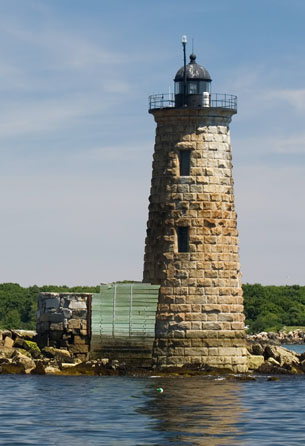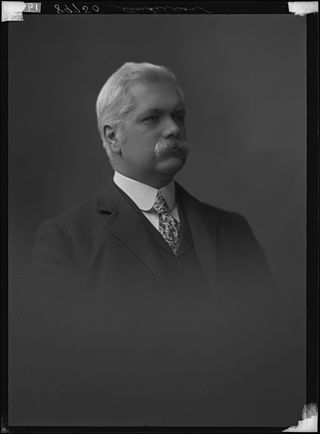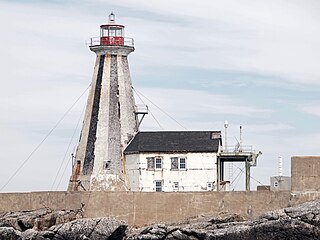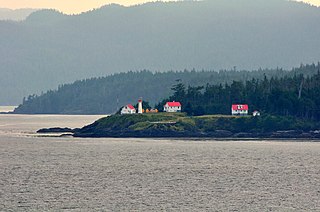
Cape Spear is a headland located on the Avalon Peninsula of Newfoundland near St. John's in the Canadian province of Newfoundland and Labrador. At a longitude of 52°37' W, it is the easternmost point in Canada and North America, excluding Greenland.

Point Iroquois Light is a lighthouse on a Chippewa County bluff in the U.S. state of Michigan. Point Iroquois and its light mark the division line between Whitefish Bay and the western end of the St. Marys River, the connection between Lake Superior and other Great Lakes.

Grand Bank or 'Grand Banc' as the first French settlers pronounced it, is a small rural town in the Canadian province of Newfoundland and Labrador, with a population of 2,580. It is located on the southern tip or "toe" of the Burin Peninsula, 360 km from the province's capital of St. John's.

The New Presque Isle Light was built in 1870, at Presque Isle, Michigan, east of Grand Lake, and sits on the namesake peninsula. It is one of 149 lighthouses in Michigan, more than any other state. Because of changing shoreline particularly, or alternatively deterioration of the original building, it is not uncommon for a replacement lighthouse to be placed in the vicinity of an earlier light, in this case, the Old Presque Isle Light.
Cape Bauld is a headland located at the northernmost point of Quirpon Island, an island just northeast of the Great Northern Peninsula of Newfoundland in the Canadian province of Newfoundland and Labrador.

A lighthouse keeper or lightkeeper is a person responsible for tending and caring for a lighthouse, particularly the light and lens in the days when oil lamps and clockwork mechanisms were used. Lighthouse keepers were sometimes referred to as "wickies" because of their job trimming the wicks.

Sambro Island Lighthouse is a landfall lighthouse located at the entrance to Halifax Harbour, Nova Scotia, on an island near the community of Sambro in the Halifax Regional Municipality. It is the oldest surviving lighthouse in North America and its construction is a National Historic Event.

Whaleback Light is a historic lighthouse marking the mouth of the Piscataqua River in Kittery, Maine. It is located on a rocky outcrop offshore southwest of Fort Foster and south of Wood Island in Kittery. The present tower was built in 1872. It was listed on the National Register of Historic Places in 1988.

Mount Desert Light is a lighthouse on Mount Desert Rock, a small island about 18 nautical miles south of Mount Desert Island, in the U.S. state of Maine. While the first light station was established in 1830, the current lighthouse was built in 1847. It was listed on the National Register of Historic Places as Mount Desert Light Station in 1988. It is currently owned and operated by the College of the Atlantic, located in Bar Harbor, Maine.

William Patrick Anderson (1851–1927) was a Canadian civil engineer. He was Superintendent of Lighthouses for almost 40 years, and was responsible for many of the more notable lighthouses in Canada.

Low Point Lighthouse is an historic Canadian lighthouse marking the eastern entrance to Sydney Harbour at New Victoria, Nova Scotia, near New Waterford, Nova Scotia. This is one of the earliest and most important light stations of Nova Scotia, one of the first dozen beacons in Nova Scotia to be lit to guide mariners, a classic red-and-white lighthouse still operated by the Canadian Coast Guard.

Point Atkinson Lighthouse is a lighthouse erected on Point Atkinson, a headland in southwestern British Columbia named by Captain George Vancouver in 1792, when he was exploring the Pacific Northwest in the ship Discovery. The first wooden lighthouse went into service in 1875 and was replaced by a reinforced concrete structure in 1914.

The major Trial Island is home to the Trial Islands Lighthouse which is operated by the Canadian Coast Guard, and continues to be staffed by two full-time lightkeepers. The current lighthouse was erected in 1970 to replace the original lighthouse that was constructed in 1906. The fourth order Fresnel lens from 1906 was used until it was replaced in 1970. That original lens is now on display courtesy of the Maritime Museum of British Columbia in Bastion Square in Downtown Victoria.

Cape Pine Light was built on Cape Pine, Newfoundland by the British architect and engineer Alexander Gordon in 1851.

The Woody Island Lighthouses are a pair of heritage-listed lighthouses at Big Woody Island in the Great Sandy Strait, Hervey Bay, Fraser Coast Region, Queensland, Australia. They were built from 1866 to 1870. It was added to the Queensland Heritage Register on 30 March 2001.

The Gannet Rock Lighthouse is a Canadian lighthouse located on a rocky islet 8 miles (13 km) south of Grand Manan in the Bay of Fundy. It was first lit in 1831 and was staffed until 1996. It was solarized in 2002 and remains operational in 2023. It was declared "surplus to requirements" by the Canadian Coast Guard in 2010 and is no longer being maintained.

The Long Eddy Point Lighthouse is a Canadian lighthouse on Grand Manan Island in the Bay of Fundy. The navigation station was first established in 1874 as a fog alarm only and operated as such until 1966, when the present structure was built incorporating a lighthouse. The building has been designated a heritage lighthouse under Canada's Heritage Lighthouse Protection Act.

Grandique Point Lighthouse is an aid to navigation for Lennox Passage, which is the channel of water between the southern shore of Cape Breton Island and Isle Madame, Nova Scotia, Canada. The lighthouse is located on the beach at Grandique Point in Lennox Passage Provincial Park and is accessible by a gravel road within the provincial park. The site is open to the public, the tower is closed.
The Cape Croker Lighthouse is a lighthouse located on the south-east corner of Neyaashiinigmiing 27 native reserve in Ontario, Canada. It is a part of the Chippewas of Nawash Unceded First Nation.

Scarlett Point Lighthouse is a lighthouse erected on the northeast side of Balaklava Island, known as Scarlett Point, about 15 km northwest of Port Hardy, in the Regional District of Mount Waddington, Province of British Columbia, Canada. This lighthouse is managed by the Canadian Coast Guard.


















